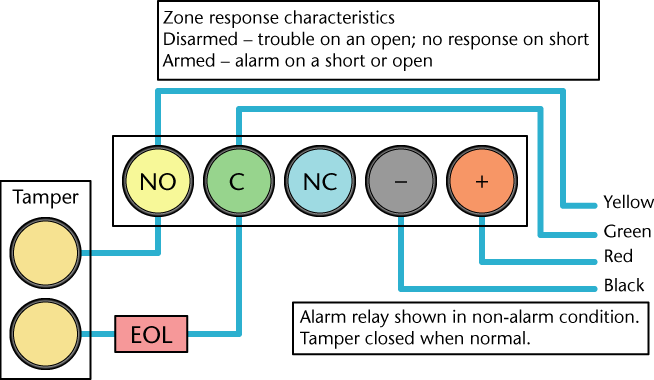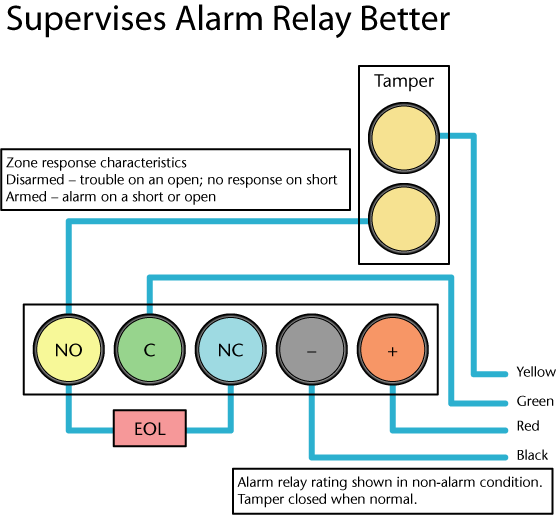a. 634
b. 635
c. 639
d. None of the above
2. When installing NC door contacts (open on alarm), the EOL resistor should be placed:
a. at the device in parallel with the contact.
b. at the device in series with the contact.
c. at the control in parallel with the zone terminals.
d. at the control in series with the zone terminals.
e. None of the above
3. When installing NO door contacts (short on alarm), the EOL resistor should be placed:
a. at the device in parallel with the contact.
b. at the device in series with the contact.
c. at the control in parallel with the zone terminals.
d. at the control in series with the zone terminals.
e. None of the above
4. A motion detector that uses a transmit frequency of 20 to 40 KHz is referred to as being a:
a. photoelectric detector.
b. ultrasonic detector.
c. microwave detector.
d. None of the above
5. A motion detector that uses a transmit frequency of 10 to 20 GHz is referred to as being a:
a. photoelectric detector.
b. ultrasonic detector.
c. microwave detector.
d. None of the above
6. PIRs transmit on a frequency of 100 to 200 KHz.
a. True
b. False
7. PIRs are most sensitive to motion toward and away from the detector.
a. True
b. False
8. Microwave detectors are most sensitive to motion toward and away from the detector.
a. True
b. False
9. Biased magnetic contacts are used for:
a. loosely fitting doors and windows.
b. high security applications.
c. wet environments.
d. explosive environments.
e. None of the above
10. Microwave detectors can penetrate what type of com- mon construction material?
a. Glass
b. Wood paneling
c. Sheetrock
d. All of the above
e. None of the above
11. Dual technology motion detectors are used to reduce power consumption.
a. True
b. False
12. PIRs utilize the Doppler shift principle to detect motion.
a. True
b. False
13. Reed contacts are plated with rhodium or similar materials to reduce cost.
a. True
b. False
For a Switch, Detect This Error
If the control panel is the brains of a security system, then the detection devices are the senses that allow the system to detect and react to possible intrusions. For these devices to function properly, you must select the correct device and install it so it will detect an attack but not cause any false alarms. To check your detector smarts, take the following quiz.
What’s Wrong with This?
Wally `Larman installed a motion detector with a tamper switch that was intended to alert the user if someone removed the cover of the device. Wally selected a motion detector with a tamper that is closed when the cover is in place and wired the unit as shown in this diagram. After programming the control for the proper zone parameters, Wally tested the device but found that he could walk up to it and remove the cover without tripping the alarm. However, as he was returning to the control, the zone did finally go into trouble. Can you see what Wally did wrong and what he should do to correct the problem?1. c – UL 639 covers intrusion detectors. UL 634 covers connectors and switches, and UL 635 covers insulated bushings.
2. b – Since the contact is closed when normal, the eol should be in series with the device.
3. a – Since the contact is open when normal, the eol should be in parallel with the device. For proper zone supervision, the eol should not be installed at the control.
4. b
5. c
6. b – PIRs are passive devices, which means they do not emit or transmit any energy.
7. b – PIRs are most sensitive to motion across the detection pattern.
8. a – Unlike PIRs, microwave and ultrasonic detectors are most sensitive to motion toward and away from the detector.
9. b – A biased magnetic contact is used for high security applications because it is more difficult to defeat by using an external magnet. Wide gap contacts should be used on loosely fitting doors and windows. Sealed and intrinsically safe switches should be used for wet or explosive environments, respectively.
10. d – Microwaves can penetrate all these common construction materials. They also can be channeled through metal ductwork or detect liquid moving inside plastic pipes.
11. b – Dual technology detectors are used to reduce false alarms because two different detection technologies must be activated for an alarm to be generated.
12. b – PIRs operate by detecting a change in infrared energy. Microwave and ultrasonic detectors utilize the Doppler shift principle to detect motion.
b – Plating of reed contacts is done to prevent welding of the contacts.

Answers to: What's Wrong With This?
Wally caused the problem by connecting the tamper switch after the alarm relay of the device. As Wally approached the unit, it detected his motion and went into alarm condition, shorting the zone before the tamper. When he removed the cover, the unit was still in alarm, which prevented the tamper contacts from opening the zone. As he walked back to the control, the unit reset, which allowed the open of the tamper to be detected by the control. Wally should rewire the unit as shown in this diagram with the tamper before the alarm relay. In this manner, the control can sense the tamper even if the unit is in alarm. He also could wire it as shown in the alternate diagram, which will provide the same tamper protection but also will provide better supervision of the alarm relay, because the zone wiring passes through both the NO and NC contacts. When the unit detects motion using this alternate wiring technique, the zone is opened and then shorted.